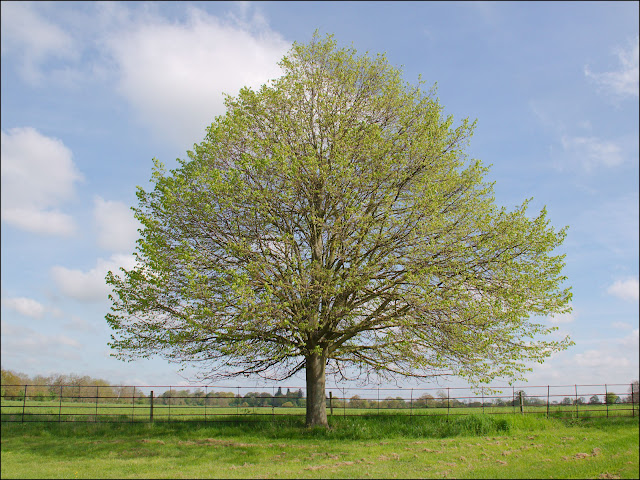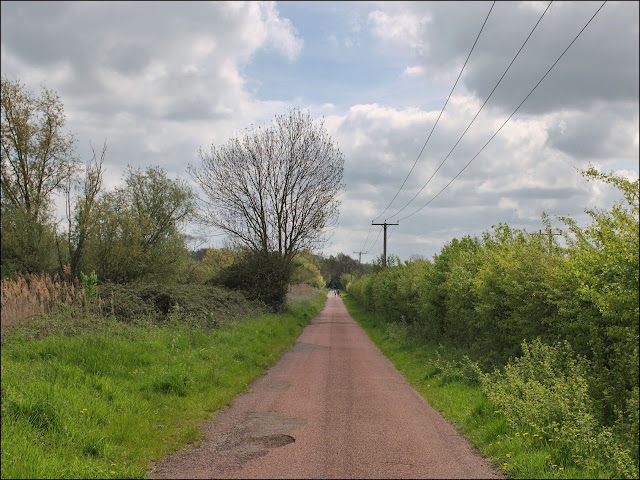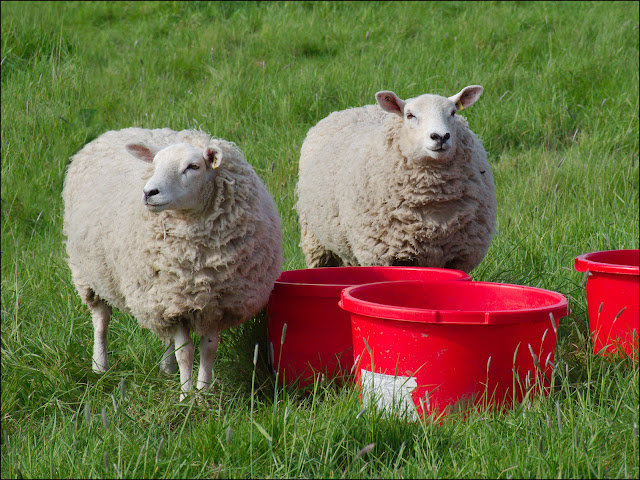It's all looking pleasantly green out there, as it has every right to be after all the showery days we've had recently. But spring continues to toddle along its way, making steady progress if not exactly leaping and skipping across the land.
We're in the vicinity of the tiny village of Diddington, in order to walk the fields and lanes hereabouts and chart the season's gentle progress.
You might be forgiven for thinking that all is unchanging and peaceful around here, but in reality the fate of these meadows is in the hands of three distinct forces - agriculture, quarrying and conservation. Most of the farming land is given over to grazing sheep and cattle.
Slowly, slowly, field by field, the quarrying company are taking over more land and extracting sand and gravel for building.
And when they are done with it, the pits are turned into an ever-expanding nature reserve. There's a lot of political bargaining and posturing going on behind the scenes I'm sure, but today let us just enjoy the scenery and wildlife that we encounter on our wanderings.
Every English village used to have at least one pond and in all likelihood two or three. They provided drinking water for livestock as well as water for local industries such as the blacksmith's shop. They were such an important resource that there were strict laws to ensure their upkeep, though gradually, as they became of little importance, ponds deteriorated and became choked with vegetation. It's unusual to find one as pristine as this.
The land around here, although officially belonging to a company, is really in the hands of a single family. They seem to be farming in a fairly low-impact way and many birds choose to inhabit the trees and hedgerows - which is, of course, why we're here.
The area is well-supplied with footpaths - that's a footpath sign, pointing both ways, at the end of the track. There are plenty of common wildflowers in the hedge-bottoms and alongside every path.
These Stitchwort flowers contrasted boldly with the rich green background. It's one of those plants that's said to be edible in salads, but it must take forever to collect enough of the tiny leaves and flowers. Besides, picking them is said to bring on thunderstorms, so best to leave it where it is.
But this is where we're heading. Now it may not look like particularly enticing scenery to you and I, but the birds think otherwise. It's an access road leading down to the waterworks. It doesn't go anywhere else, so there's only a very occasional vehicle coming this way. Only local people seem to know about its treasures.
When the road was needed, the water company, as is often the way with publicly-funded bodies, bought more land than they actually needed. At least that's my theory why there's so much scrubby unkempt land around here. Sedge Warblers were singing their little hearts out all along here. They are courageous, energetic souls and as soon as they've flown in from Africa they commence their boisterous songs. They start off singing from cover, but soon throw caution to the wind and take to open perches, occasionally launching themselves into the air when they can contain their passion no longer.
Up in the tree-tops you might identify the beautiful varied song of the Garden Warbler, a plain little bird whose main distinguishing feature is a lack of any distinguishing features. You can't see it? Neither could we!
Delicate spring blossoms may conjure up images of warm sunny evenings filled with romantic birdsong; but we're on the lookout for something very different, as are our most celebrated songsters when they arrive for the summer. Something like this....
....thorny, impenetrable thickets. And out of the dense tangle comes the sweet song of the Nightingale. It wasn't always like this - a hundred years or so ago Nightingales could be heard in orchards and gardens across southern England.
In 1924 the 'cellist, Beatrice Harrison, was practicing in her Surrey garden when she became aware of a Nightingale duetting with her instrument. The BBC were contacted and it so happened that they had just acquired some "state-of-the-art" equipment (for 1924!) and jumped at the chance to try it out. The broadcast of bird and 'cello making music together became an unexpected sensation and in 1927 four tunes were recorded by HMV and released on 78 rpm records. Would you like to hear one?
Beatrice Harrison was a well-respected classical musician of the time, but it's these recordings of her being upstaged by a bird for which she is remembered.
We stood for a long time, entranced by the songs, but unable to glimpse the birds, before wandering back to Diddington.
We haven't had a bird-list lately, so here you go:
Diddington 03/05/2023
Distance walked: 5.2 miles
Birds seen: Wood Pigeon, Rook, Carrion Crow, Jackdaw, Magpie, Blackbird, Song Thrush, Mistle Thrush, Robin, Wren, Dunnock, House Sparrow, Goldfinch, Greenfinch, Blue Tit, Great Tit, Chiffchaff, Whitethroat, Blackcap, Sedge Warbler, Garden Warbler, Nightingale (heard), Cuckoo (heard), Green Woodpecker (heard), Black-Headed Gull, Lesser Black-Backed Gull, Common Tern, Swallow, Reed Bunting, Linnet, Starling, Mute Swan, Egyptian Goose, Greylag Goose, Mallard, Tufted Duck, Cormorant, Red Kite, Hobby, Kestrel.
Take care


















One of our cats is intensely interested in the Nightingale's song as I type. What a truly lovely recording.
ReplyDeletePure bliss John - both the walk (I did it with you) and that exquisite recording.
ReplyDeleteI give the report ten out of ten. Remember when the teacher would also give you a star for exceptional work? I am bestowing a star on you too. As far as as quarries being returned to nature are concerned, from what I have read and seen when visiting visiting a couple of them, Britain has done an outstanding job with rehabilitation of the landscape. That's a pretty decent bird list too, John.
ReplyDeleteHave you read Richard Maybey's exquisite little book, "Whistling in the Dark", aptly subtitled "In pursuit of the Nightingale"? The Beatrice Harrison performance is delightfully covered in there; aside from that, however, the whole book is a literary gem in my estimation.
ReplyDeleteNo, I haven't read that book though Richard Mabey's other books are certainly excellent. We have a whole suite of wetland reserves stretching along the River Great Ouse and out into the fens and the return of so many birds is testament to their success. Now all we need is more sustainable farming and more woodlands!
DeleteHi David and John - oddly I picked up Mabey's book in the last few months ... and used it for a reading somewhere ... but this is a great post - loved it - thank you - cheers Hilary
DeleteAn excellent report, John! I am especially grateful for the links to the bird sounds.
ReplyDeleteI was surprised at the look of the nightingale as I imagined it looked much fancier!
What a beautiful sound the bird and instrument make. Thanks.
ReplyDeleteAnother wonderful walk and lesson combined. Listening to the recording as I type this comment. Charming! My husband's nickname as a child was Danny! Now it's just Dan.
ReplyDeleteWhat a beautiful long walk you had there. Each photo shows us the splendid spring unfolding. Love the bird song video.
ReplyDeleteIt is indeed a green and pleasant land, as your photos so well demonstrate. I can't hear the birds but I'm sure that's another delightful layer on top of the visual.
ReplyDeleteWhen a Garden Warbler starts singing I never think he is going to stop.
ReplyDeleteThe problem with these companies creating Nature reserves, it usually ends up with a lot of water and a few Mallard Ducks.
The new areas here are going to be an extension to Paxton Pits Reserve, so I have hopes that it will be well run, The few people who have access at the moment have reported a good variety of species.
DeleteThe bird and cello are priceless and such an old recording. What a treasure! That brings a smile this morning! Thank you!
ReplyDeleteThe bird and cello make a great song together. Thank you!
ReplyDeleteForgot to say that you are very fortunate to have access to the walking trails.
ReplyDeleteAnother beautiful walk! The bird and the cello make my day. Thank you.
ReplyDeleteThat is a long bird list, John! Quite the place for birds, for sure. I like that little flower too, especially the folklore associated with it.
ReplyDeleteLoved the cello and Nightingale music! Our land isn't quite as green yet.
ReplyDeleteI read about the nightengale and the cellist. I've heard some of the recordings too, and it just please me to think that a bird might get as much pleasure out of our music as we do of theirs!
ReplyDeleteI enjoyed the walkvery much. Thank you for including the recording.
ReplyDeleteAnother good walk, thankyou.
ReplyDeleteWhich of these have broken leaf first for you..oak or ash?
I'm not sure, but we've certainly had a soaking recently!
DeleteOn a bird trip to Rutland water with a much loved friend some years back we stood transfixed by a singing bush as a nightingale sang it's heart out.
ReplyDeleteShe died this time last year. Danny Boy was one of her favourites.
Happy memories.
What a delightful post! I immensely enjoyed the duo of the cutest singer Nightingale and Cellist. While walking in the green countryside and listening to the music, I was forgetting about the ugly things happening in the world.
ReplyDeleteThe sheep look so innocent and cute! You have a great approach to composition. Every frame tells a story.
ReplyDeleteThe sheep look quite at ease.
ReplyDeleteJohn, thank you for another wonderful walk. You just cannot beat the English countryside.
ReplyDeleteEnjoyed the walk, as always, John and it was nice to read that the land in being well cared for by one family and it seems that it is being well cared for and managed.
ReplyDeleteBeatrice Harrison was indeed upstaged by the nightingales, but in all honesty I would not have listened to more than the track you included, John. while a sensation in the 1920s, I wonder if the same would be true today.
Muy buenos paisajes,. Depués de hartas de comer, las oveja se retiran a descansar.
ReplyDelete